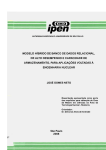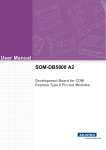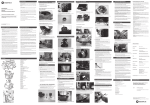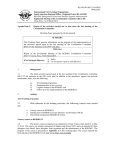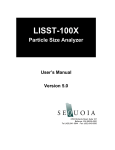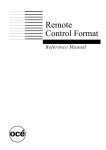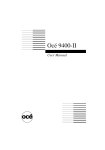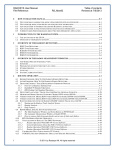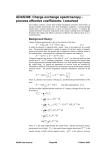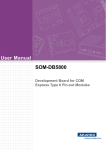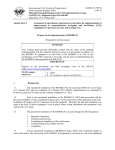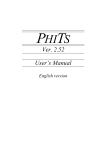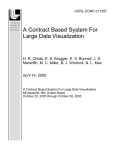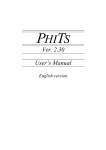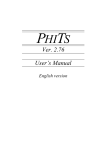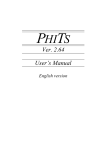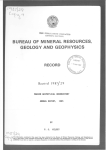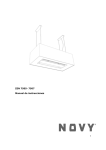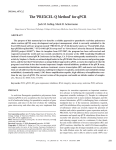Download JISCARD EX Personal Edition User`s Manual ver.1.0
Transcript
JISCARD EX Personal Edition User’s Manual ver.1.0 http://www.nirs.go.jp/research/jiscard/ex/index_ex_e.html Hiroshi Yasuda National Institute of Radiological Sciences October 20th, 2008 The names of companies, commercial products or services referred in this document are generally trademarks or trade names of manufacturers. © 2008 Hiroshi Yasuda / National Institute of Radiological Sciences 1 Index 1. Notices for Use........................................................................................................... 3 2. How to Use the Program .......................................................................................... 4 2-1. When flight path is known .................................................................................... 6 2-2. When flight path is unknown ................................................................................ 9 3. Program Description ............................................................................................... 15 3-1. Outline of the program ........................................................................................ 15 3-2. Comparison with Other Programs....................................................................... 17 Acknowledgements ........................................................................................................ 19 References ..................................................................................................................... 19 2 1. Notices for Use The program “JISCARD EX Personal Edition” is developed by National Institute of Radiological Sciences (NIRS). Any materials (codes, databases, figures and documents) of this program belong to the manufacturer (NIRS and the author of this document) and protected by national copyright laws. Copies of the program may be made for personal use as allowed by the copyright laws. Permission of the manufacturer is required for all other use, including multiple or systematic copying, copying for advertising or promotional purposes, etc. If you need permissions, you can send an e-mail to the manufacturer ([email protected]). Results obtained using this program may be published or distributed externally, as long as you refer to this guide in the following style: 1) Hiroshi Yasuda: JISCARD EX Personal Edition User’s Manual (ver.1.0), 2008, http://www.nirs.go.jp/research/jiscard/ex/manual_e.pdf The program should be considered as a personal tool, and not used for administrative purposes. The calculation algorithms, data, or parameters may have some errors that we have not yet identified. No responsibility is assumed by the manufacturer for any injury and/or damage to persons or property from any use or operation of the program or data contained in this work. The program is carefully tested with Microsoft Excel 2003 and Internet Explorer 7 on Windows XP, and confirmed to be safe for normal operation of other software, operating system and PC. However, there could be errors in user with other software, PCs, and/or printers. It is impossible to test the program on the full spectrum of those combinations. The program may be changed for further improvement without notice. As results, some part of figures and instructions in this document may be different from reality. 3 2. How to Use the Program First, access the web page for downloading the program: http://www.nirs.go.jp/research/jiscard/ex/index_ex_e.html Next, click “Program files” and download the archive program (ZIP file) to your PC. 4 Extract the ZIP file and then open an Excel file “JISCARD-EX-P_e.xls”. As to macro setting, make the macro function effective. In advance, you need set the macro security level of Microsoft Excel as “Medium”. Next, input the password to a box. For the first time or if you forgot the password, please send an e-mail to the manufacturer ([email protected]) with the subject of “password request”. Soon after password input, the “MainSheet” (below) appears on the display. 5 2‐1. When flight path is known Input a log data of flight path (time from departure, latitude, longitude and altitude) to the mainsheet cells. Also, input other information on airport locations, departing time and cruising time to another “Parameter” sheet. The information on airports can be obtained using a web tool “AIRPORT SEARCH” as explained in the next chapter. 6 Completing data input, then push the “Route Dose Calculation” button in the left panel of the mainsheet. 7 Shortly, calculation results including flight conditions, route doses (effective dose and1cm ambient dose equivalent), solar magnetic potential, trend graphs (dose rate, altitude and geomagnetic cut-off rigidity potential) and the figure of flight route are automatically summarized in report style on another worksheet as shown below. Date: 2008/10/18 Program: JISCARD EX v1 Username: Parma Jiscard Calculation results 1. Date & Time 2008/10/18 13:34 2. Departure: Ministro Pistarini Internacional (SAEZ/EZE), Argentina 3. Arriving: Dallas Fort Worth International (KDFW/DFW), U.S.A. 4. Fying time: 11:29 Mileage: 5. Solar potential: E rate H*(10) rate 406.756 MV Effective dose E: Ambient dose eq. H*(1 2.45E-02 mSv 2.94E-02 mSv Time vs Do se rate from SAEZ_EZE to KDFW_DFW Dose r ate (microSv / h) 6. Route dose: 5317 Miles 6.00E+00 5.00E+00 4.00E+00 3.00E+00 2.00E+00 1.00E+00 0.00E+00 0 2 4 6 8 10 12 14 10 12 14 10 12 14 Time (hr) Altitude: Time vs Altitude fro m SAEZ_EZE to KDFW_D FW Altitude (f t) 4.00E+04 3.00E+04 2.00E+04 1.00E+04 0.00E+00 0 2 4 6 8 Time (hr) Cut-off rigidity: Time vs Rc from SAEZ_EZE to KDFW_DFW Rc (GV) 1.50E+01 1.00E+01 5.00E+00 0.00E+00 0 2 4 6 8 Time (hr) Route: 8 2‐2. When flight path is unknown When flight path data are unavailable, you can get geographical information of airports from an original program. Push the “Airport Search on Web” button on the mainsheet. A web tool “AIRPORT SEARCH”* starts automatically on the web browser of your PC. Internet Explorer 6 or more is recommended for this tool. Adobe Flush (9.45 or more) is also necessary. *URL http://www.nirs.go.jp/research/jiscard/ex/index_aptsrch_e.html 9 Input a part of airport or city name or code in the box and push “by name” or “by code” button, respectively. Clicking the full airport name that has appeared below the box, you find a balloon in the right box area of Google Maps. Check the information on the airport and, if it is what you looked for, click “Select this airport” in the balloon. 10 After selecting both departing/arriving airports, click “Copy to the Clipboard” at the bottom in the left box. 11 Gong back to the mainsheet, then push “Parameter Settings” button in the left panel. 12 A pop-up panel shows information on flight conditions such as airport locations, flying date and time are displayed as shown below. Great circle route is calculated for points with 10min intervals in default. After confirmation and necessary modification, push “Output to mainsheet” button. 13 Flight path data along the great circle route are automatically given on the mainsheet cells. Now you can push “Route Dose Calculation” button for the calculation of route dose. A summary report will be made soon. Other boxes and buttons on the mainsheet are for optional use. manufacturer ([email protected]) for questions. 14 Please ask the 3. Program Description Cosmic radiation intensities at aviation altitude (10~12km) are much higher than those on the ground and most of aircraft crew receive additional doses of more than 1mSv per year, i.e. the dose limit recommended for the general public. Accordingly, ICRP states that radiation exposure during the operation of jet aircraft should be considered as occupational exposure [1,2]. This recommendation has been followed most in Europe; the European Union (EU) has made a directive which orders member countries to perform assessments of cosmic radiation exposure for aircraft crew [3]. In Japan, the government has requested domestic airline companies to follow the guidelines made by the Radiation Council in 2006 [4] which states that annual aviation doses of aircraft crew are to be kept below 5mSv per year. The National Institute of Radiological Sciences (NIRS) has helped the airline companies to follow this guideline, particularly for calculation of aviation route doses. As a by-product of this work, this personal-use program, named as “JISCARD EX Personal Edition”, has been developed. 3‐1. Outline of the program This program is written with Excel VBA (Visual Basic for Applications) language and runs on the platform of Microsoft Excel 2003/2007. The dose rate at a point in the atmosphere is calculated using newly recommended radiation weighting factors [2] with a new analytical model that is recently developed in Japan [5]. The flow of tasks for route dose calculation is shown in Fig.1. To use this program, just open an Excel file with a default name of “JISCARD-EX-P_e.xls”. On the first mainsheet as explained in the previous chapter, you can select one of three procedures according to how much flight path data are available. Also, as another procedure, a CSV-format data file of flight path can be uploaded from memory devices. 15 Main program (JISCARD-EX-P.xls) 3 1 Select a procedur AIRPORT SEARCH (Original web program to get 2 Input flight log data and other parameters Determine departing and arriving airports. Is the route interpolation necessary ? No Calculate a greatcircle route Yes Calculate a great circle route Set other parameter values Calculate a route dose using PARMA and output results Userfile (*.xls; report, route, condition, etc.) Fig. 1: The task flow of route dose calculation using JISCARD EX. Geomagnetic cut-off rigidities (Rc) at passing points are calculated with a GEANT4-base particle tracing code “MAGNETOCOSMICS” [6] developed by the cosmic ray group of the University of Bern. The newest version, which will be effective until 2010, is used here. The incident particle spectra of galactic cosmic rays (GCR) around the Earth are given from the local interstellar (LIS) spectra. Effects of solar modulation are evaluated with the model of Nymmik et al.[7] coupled with modified empirical parameters based on the force field formalism. 16 According to the Rc values and GCR spectra that were independently estimated, cosmic radiation dose rates at passing points are calculated with the PHITS-based Analytical Radiation Model in the Atmosphere “PARMA” developed by Sato et al [5]. PARMA can calculate cosmic radiation doses in the atmosphere in a short time as precisely as Monte Carlo simulation (PHITS code) can. Total effective dose and 1cm ambient dose equivalent are obtained as integrals of dose rates along the flight path. 3‐2. Comparison with Other Programs Several programs are now available for route dose calculation, such as CARI-6 [8], EPCARD [9], SIEVERT [10] and PCAIRE [11]. The characteristics of these models including properties of other models and services are well explained in a report by the European Radiation Dosimetry Group [12]. In Fig.2, effective doses calculated with JISCARD EX are compared to those with CARI-6 for selected international flights. The estimations of JISCARD EX are 20~50% (30% in average) lower than those with CARI-6; no higher value was found. The effective doses obtained with JISCARD EX are lower also than those with EPCARD [9] and SIEVERT [10], though the results are not shown here. The main reason for these results is due to the recent revision of the radiation weighting factor (wR) values [2]. The wR values for neutrons are considerably lower than those in the 1990 recommendations [1]. Also, the difference is attributable to employment of the new model for radiation transport [5] which improved the accuracy for estimation of neutron energy spectra, particularly for cosmic-ray neutrons with energies greater than 10MeV. 17 Fig.2: Comparison of the effective doses calculated with CARI-6 and JISCARD EX for 33 round-trip international flights between major cities and Tokyo/Narita airport. It should be noted that difference of ambient dose equivalent between JISCARD EX and other programs becomes smaller than that of effective dose, since the H*(10) values obtained with JISCARD EX are about 20% higher than effective doses. Comparison with other programs for route dose calculation [8-11] may be valuable in discussing the uncertainties which accompany to cosmic radiation dosimetry, i.e. nuclear reactions of high-energy particles up to GeV. Finally, this program is expected to be a useful tool for educational purposes to facilitate understanding of natural radiation in the environment and also radiation exposure in aircraft. 18 Acknowledgements The author thanks Dr. Tatsuhiko Sato, Japan Atomic Energy Agency, for his great efforts to develop the PARMA code. Sincere appreciation is expressed to Mr. Masato Terakado, Mr. Susumu Ryufuku and Mr. Takumi Ajima, Visible Information Center, Inc. for technical cooperation in the program development. References [1] INTERNATIONAL COMMISSION ON RADIOLOGICAL PROTECTION, The 1990 Recommendations of the International Commission on Radiological Protection, Publication 60, Pergamon Press, Oxford (1991) [2] INTERNATIONAL COMMISSION ON RADIOLOGICAL PROTECTION, The 2007 Recommendations of the International Commission on Radiological Protection, Publication 103, Pergamon Press, Oxford (2007) [3] EUROPEAN UNION, Council Directive 96/29/EURATOM of 13 May 1996 laying down the basic safety standards for protection of the health of workers and the general public against the dangers arising from ionizing radiation. Off. J. Eur. Commun. L159 (1996) [4] MINISTRY OF EDUCATION, CULTURE, SPORTS, TECHNOLOGY, SCIENCE AND http://www.mext.go.jp/ b_menu/shingi/housha/sonota/06051009.htm (in Japanese) [5] SATO, T., YASUDA, H., NIITA, K., ENDO, A. AND SIHVER, L., "Development of PARMA: PHITS-based Analytical Radiation Model in the Atmosphere" Radiat. Res. 170, 244-259 (2008) [6] COSMIC RAY GROUP, PHYSIKALISCHES INSTITUTE, UNIVERSITY OF BERN, http://cosray.unibe.ch/~laurent/magnetocosmics/ [7] NYMMIK, R. A., PANASYUK, M. I., PERVAJA, T. I. AND SUSLOV, A. A., A model of galactic cosmic ray fluxes. Nucl. Tracks Radiat. Meas. 20, 427-429 (1992). 19 [8] FEDERAL AVIATION ADMINISTRATION: Radiobiology Research Team web page, http://www.faa.gov/education_research/research/med_humanfacs/aeromedical/radi obiology/cari6/index.cfm [9] NATIONAL RESEARCH CENTER FOR ENVIRONMENT AND HEALTH: EPCARD, http://www.gsf.de/epcard2/index_en.phtml [10] SIEVERT web page: http://www.sievert-system.org/WebMasters/en/index.html [11] PCAIRE Inc. : http://www.pcaire.com/ [12] EUROPEAN RADIATION DOSIMETRY GROUP: “Cosmic radiation exposure of aircraft crew: compilation of measured and calculated data”, A report of EURADOS Working Group 5. European Commission: Luxembourg (2004) 20 JISCARD EX Personal Edition ver.1.0 User’s Manual Publisher: Author: National Institute of Radiological Sciences 9-1, Anagawa 4, Inage-ku, Chiba 263-8555, Japan Hiroshi Yasuda Research Center for Radiation Protection National Institute of Radiological Sciences E-mail: airdose @ nirs.go.jp Web page: http://www.nirs.go.jp/research/jiscard/ex/index_ex_e.html * A part of this document could be changed without notice. * This work is protected by copyright laws internationally. 21






















